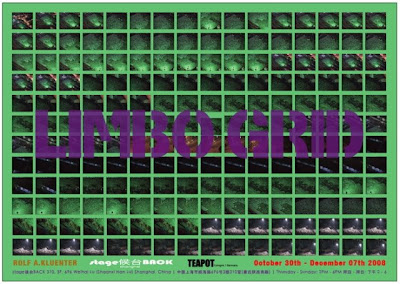
Limbo Grid provides an insight into Kluenter’s cosmology and his observation of urbanity as an awe-inspiring reality. These aspects of Kluenter’s aesthetics might bear strong reminiscences of scenes and atmospheres of 19th century Romanticism. In contrast, however, his recourses and references rather relate to the “Darkness” of a mega-urban scenario than to the “Mighty of Nature”.
In his installation, a multi-layered net-like structure metaphorically plays the central role. The net-like structure is made of fragile blackened Nepalese handmade paper. It hangs down from the ceiling and divides the space into two rooms. As a contra-point to the dominant black paper-structure, a film projection is set on the opposite wall. The short film is based on a variety of nightshift scenes which Kluenter filmed during the past years at one of central Shanghai’s many construction sites. The film music is composed of several commonly known sound-fragments that Kluenter has re-arranged and re-mixed to enhance the scenes of the film.
Tiny objects that are attached to the lower and upper ends of the blackened paper grid further alienate the work. A very small staircase made of Lego-toys comes forth from the lower end and reaches to the ground where small plastic toy-puppets stand to welcome the descendants. A welcome banner reads: “Welcome back from Limbo. Welcome to our brave new world”. From the upper end of the paper-grid, joined plastic drinking straws emerge and extend into space as a loop. Attached to the plastic drinking straw structure, black scrolls are hanging down on which a variety of statements are written that relate to the term “heaven”. During the exhibition period until December 7, Kluenter will be adding one statement on “heaven” on each day.
Since the installation and film figuratively evoke a state of non-resolution and uncertainty, the connotation of a “Limbo”, a term that has been frequently used in literature, becomes obvious. Limbo is a place or state of oblivion to which persons or things are regarded as being relegated when cast aside, forgotten, past, or out of date. Spiritually and in scholastic theology, limbo is an extramundane region where certain classes of souls were supposed to await their judgment.
Blackened Nepalese paper has been the primary ground and substance of Rolf A. Kluenter’s work for the past years. Blackness essentially suggests the absence of a source of light and the notion of void. Its nature evokes the limits of the visible. The hand-made structures of the blackened Nepalese net-like paper object show an excessive load of irregularities.
Like an ongoing experiment, Kluenter’s approach is to display his works in series as ever so many declinations of basic emotional positions. Life and art are situated between cultures, crossing borders, intersecting at cross-cultural pathways: process of change, fluctuation and spatial-geographic traceless-ness, interdisciplinary paradoxes, wordless and non-conceptual messages simulating unlimited virtual variety.







No comments:
Post a Comment